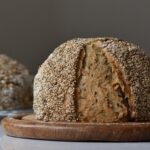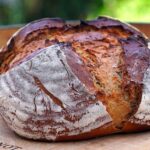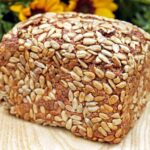
Authentic-tasting German bread is easier to make than you’d think. Bauernbrot, or farmer’s bread, is a hearty rye bread that is the standard loaf in many German homes, especially in the south. It was traditionally made from scratch in farm homes and baked in age-old, wood-fired ovens. It takes a few hours from start to finish, but most of that time is spent resting the dough or baking it. The final product has a dense crumb, full flavor and a chewy crust.
Ingredients:
Starter:
1 1/2 ounces (42 g) compressed fresh yeast
4 cups warm water
2 tablespoons white sugar
4 cups all-purpose flour
Dough:
8 cups rye flour
4 cups all-purpose flour
2 tablespoons salt
1 teaspoon white sugar
2 cups warm water
Preparation:
- Mix all starter ingredients in a large bowl. Cover the starter with plastic wrap and let it rest on the counter for 24 hours.
- Using a stand mixer fitted with a dough hook, add the dough ingredients to the starter, starting with ½ c all purpose flour. Add additional all purpose flour as needed to help the dough come together. Knead on the mixer for 4-5 minutes, or turn the dough out onto a lightly floured surface and knead by hand for 10-15 minutes.
Shape the kneaded dough into a ball. Cover it with a damp tea towel and let it rise in a warm, draft-free place for 2 hours. - Knead the dough a couple of times and shape it into its final round shape. Place the shaped dough onto a cornmeal-dusted baking sheet. Brush the top of the dough with a little of the egg white mixture and cut a few slices in the top of the dough, using a serrated knife. Let the shaped dough rise for 40-50 minutes.
- Close to the end of rising time, preheat your oven to 425F (220C). Bake the bread for 40-45 minutes, until the bread sounds hollow when tapped.
- Remove the bread from the baking sheet, and let it cool at least 10-15 minutes on a wire rack before cutting and serving with fresh butter.
Related recipes:
Rosinenbrot (German Raisin Bread)
Weizenbrötchen – German Rolls
Kartoffelbrot – German Potato Bread
How Germany Became the Land of Bread







